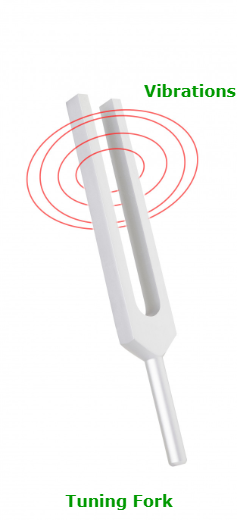振动体产生的声音
音乐连接在无法听到言语的地方。音乐和声音是我们日常生活的一部分。声音是一种使我们能够听到的能量。我们通过用眼睛感知它们发出的光来查看我们周围的物品。类似地,耳朵被用来感知声音。事物的振动会产生声音,声音会通过介质从一个地点传输到另一个地点。
物品的来回运动称为振动。振动是由物体的运动引起的。在许多情况下,我们可以亲眼看到振动。虽然在某些情况下它们的幅度很小,以至于我们看不到它们,但我们可能只能感觉到它们。让我们更深入地讨论振动体产生的振动和声音。
什么是振动?
声音是一种由振动材料产生的能量。身体中的振动会在周围介质的粒子中产生振动,这些粒子以特定的速度以波的形式传播。弹拨紧字符串产生的声音就是上述陈述的一个例子。
Vibrations propagate through a medium such as air to our ears, where they are perceived as sound by the brain.
一些物体的振动可以很容易地观察到,但在声音幅度较小的情况下,很难看到振动。例如,当弹奏吉他时,弹拨吉他字符串,它会振动并发出声音。它产生的这种声音通过空气传播并到达我们的耳朵。
拉伸的动物皮(如鼓和桌子)、拉伸的字符串(如吉他和西塔琴)或气柱可以用作振动体(如长笛或管子)。
声波
声波是能量在介质(如空气、水)中传播时所产生的扰动的排列,该能量从声源传播开来。源是任何引起振动的物体,例如铃声或某人的声带。物体产生的振动会干扰周围介质中的其他粒子,进而干扰它们旁边的粒子,依此类推。这种扰动顺序以波浪状模式产生向外运动,该运动通过介质传递声能,通常在所有方向上,但当它远离源物体时强度较小,称为声波。
声波的产生
通常,声波是由声源物体的振动、声音传播介质中存在的粒子(原子或分子)以及听者的耳膜产生的。因此,当通过任何物体的振动产生声音时,它会导致空气分子撞击它的相邻分子,然后撞击它旁边的分子,以此类推。有一系列的碰撞以声波的形式穿过介质。

声波的成分
Following are some terms related to the sound wave:
- Amplitude – It is defined as the maximum vertical displacement of the wave from its mean position.
- Wavelength – It is defined as the distance between the consecutive peaks of the wave.
- Frequency – It is defined as the time rate of the vibrations that occurred in the sound wave traveling through the medium. Its unit is Hertz (Hz) and mathematically it is given as,
Frequency (F) = 1/Time period (T)
振动体产生的声音示意图
音叉
通常,音叉由一个手柄和两个叉子和一个手柄组成。通过调音产生的声音是在使用橡胶敲击时产生的,在两次产生振动。这种来回的时间运动导致附近存在的空气分子中产生扰动。因此,这有助于使用音叉产生声波。

乐器
音乐和声音是我们日常生活的一部分。来自塔布拉、风琴、吉他、鼓、长笛等乐器的悦耳声音来自每种乐器中存在的不同振动源。在小鼓和鼓中,振动源是音乐家演奏的膜。类似地,在吉他中,振动源是字符串,而在长笛中是吹入空气的气柱。因此,在每个振动部分产生的振动导致周围的干扰导致通过乐器听到音乐。 Musical Instrument Vibrating Part Sitar Stretched string Veena Stretched string Mridangam Stretched string Shehnai Air Column Drum Stretched string Flute Air Column Mouth Organ Air Column Tabla Stretched string Violin Stretched string1. 2. 3. 4. 5. 6. 7. 8. 9.
自行车铃
让我们端对端敲响自行车铃,用指尖轻轻触摸它。响起的自行车铃反复来回摇晃。如果我们将响起的自行车铃牢牢地按在手中,它就会停止振动,声音也停止了。通过以这种方式振动自行车铃来发出声音。
拉伸橡皮筋
拉伸橡皮筋末端并将其紧紧系在固定在桌子上的两个钉子之间,在此位置橡皮筋不会振动,因此不会产生任何声音。用手指从中间拉出拉长的橡皮筋。橡皮筋开始振动并发出声音。因此,拉伸的橡皮筋振动时会发出声音如果我们用手紧紧握住正在振动的橡皮筋,橡皮筋就会停止振动,它发出的声音也会停止。
示例问题
问题1:物体做什么来产生声音?
回答:
An object must vibrate that is the back and forth motion of an object to produce the sound. Vibrations are caused by the movement of things.
问题 2:发出声音的物体与无声的物体有何不同?
回答:
A sound-producing body vibrates, whereas a quiet one does not. Even by touching, the two bodies may be distinguished: some vibrations or sensations may be felt in a body that makes sound, but they are lacking in a quiet one.
问题3:是什么让我们听到手机铃声?
回答:
The vibration of particles presents in the air makes the sound of a ringing bell to reach our ears.
问题4:声音的原因是什么?
回答:
The simple yet quick mechanical vibrations of various elastic substances produce sound. These, when moved or struck, transmit the same type of vibrations to the auditory nerve of the ear, which is then appreciated by the mind.
问题 5:声音是由身体的振动产生的。你如何展示它?
回答:
The body vibrates, and the vibrations of the particles in the surrounding medium reach us. A medium is required for sound transmission. The vibration of the body causes vibration in the particles of the surrounding medium, which travel in the form of waves at varying speeds depending on the density and elasticity of the medium.